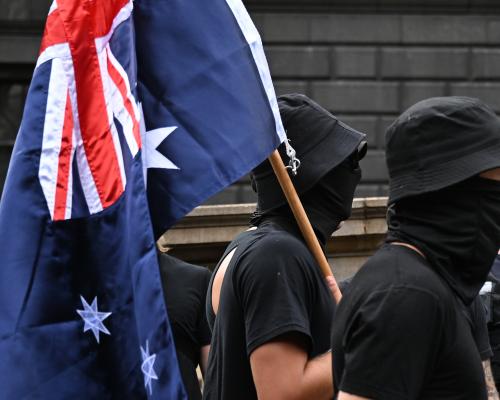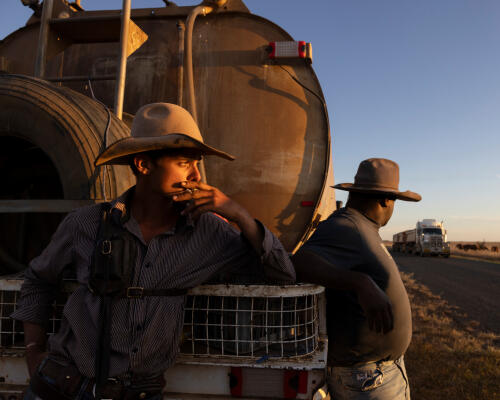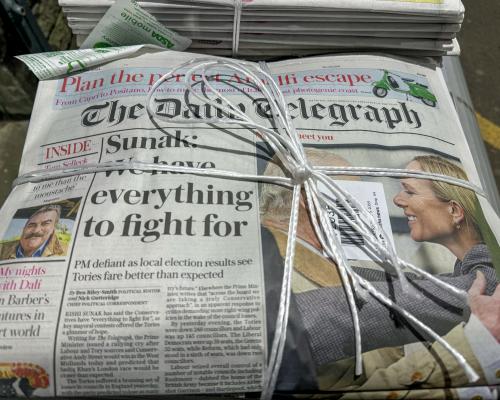
It can be a wicked problem, working out how to report on, for example, potentially racist marches. Do you refuse to give them airtime? Mention them but be sure not to glorify them? How much detail do you include?
There are plans under way for a “March for Australia” that is taking place (according to one of the anonymous organisers – multiple people claim to be in charge) on 31 August.
Sydney’s Daily Telegraph strongly featured the flyer for the event, with the date and time and the March’s slogans at the top of the story. News.com.au worried that the protest had sparked a “divisive debate” (as opposed to itself being divisive). Both also pointed out racist links.
The original flyer talked about taking Australia “back”, although it didn’t clarify to where. And it demanded “no foreign flags”, although the background showed the union jack.
Comments on the social media pages of people reposting details about the march quickly filled up with racist garbage and conspiracy theories.
The neo-Nazi Thomas Sewell described it as “our” public rally in a post to Telegram, calling for “White Australians” to assemble “against the traitors and foreigners” – even as some of the organisers denied any Nazi connections.
No Robinson Crusoe
Australia’s pledge to recognise a Palestinian state was labelled many things. Pointless symbolism. Important symbolism. A move that did not go far enough. A move that would enrage Donald Trump and Israel and please Hamas.
And myriad tensions boiled over on Thursday with (some slightly confusing) reports that Hamas had welcomed the move, despite the Australian government’s pledge that there would be no role for Hamas in a future Palestine state.
Among the febrile news yarns and think pieces about the significance of Australia’s move, particularly in the News Corp papers, there was little and sometimes no mention of the group Australia has joined.
It came down to news.com.au to put it in perspective – Australia will join about 150 other nations in pledging to recognise a Palestinian state.
Most dangerous place on Earth to be a journalist
Israel has now killed more than 190 media workers and journalists in Palestine, the Committee to Protect Journalists says, with an Al Jazeera team the latest victims. Al Jazeera puts the number at closer to 270.
Anas al-Sharif and four of his colleagues were killed by an Israeli airstrike as they sat in a journalists’ tent near a hospital in Gaza City.
On Thursday the Media, Entertainment and Arts Alliance released a video of more than 100 of its members reading the names of those killed.
The MEAA media federal president, Michael Slezak, said journalists were “reporting on the horrors being inflicted on the civilians of Gaza … making it the most dangerous place on Earth to be a journalist”.
The Israel Defense Forces bragged of the kill, announcing it on social media with bullseye emoji. They claimed al-Sharif was Hamas, with scant evidence.
The Committee to Protect Journalists and al-Sharif himself had anticipated there would be retaliation for his reporting on starvation in Gaza. “If these words reach you, know that Israel has succeeded in killing me and silencing my voice,” he said.
Killing journalists is a war crime and this attack was another strike on the flow of information from Gaza.
‘Pipeline’ threat
Meanwhile, Sky News reckons it has found the real threat to press freedom. On Thursday The Australian published a piece about Victoria’s Respectful Relationships curriculum, which includes information about transgender issues. The piece referred to a terrifying-sounding “pipeline” from schools to transgender clinics.
The Victorian premier, Jacinta Allan, immediately hit back.
“Transgender kids are 15 times more likely to kill themselves … supporting those kids and supporting those families should be a priority because it’s the right thing to do,” she said.
“What’s not right is this ongoing campaign to tear down programs that are about strengthening kids’ resilience, it’s about preventing bullying, about protecting kids against future harm, that’s what needs to stop.”
She made it clear that she was referring to The Australian’s “ongoing campaign” and said the pipeline notion was “disgraceful” and “nonsense”. The Australian responded with a fairly straight news story about her comments.
Sky News, though, was having none of it. Her “disturbing attack on free and open reporting” was in a “heated defence of a radical push of transgender ideology to five-year-olds”, it said. It was a “rant”, a “full-throttled attack”.
Sky quoted Bella d’Abrera, the director of the foundations of western civilisation program at the Institute of Public Affairs, decrying “the indoctrination of children with fringe theories about sex and gender”.
Fame then defamation case
The chilling effect of Australia’s defamation laws may have thawed somewhat with a landmark ruling on the high-profile orthopaedic surgeon Munjed Al Muderis’s case.
A joint investigation by Nine newspapers and 60 Minutes aimed to counterbalance years of extensive positive media about the surgeon (including in Guardian Australia) with claims from his patients about negligent post-operative care and more.
Al Muderis launched a defamation case. The federal court dismissed it last Friday (he will reportedly appeal) in what has been called a significant test of a new public interest defence added to defamation laws in 2021.
The long-running trial’s dismissal would have been a huge relief for many – not least for the investigative journalist Charlotte Grieve. Just three days after the decision the press release for her book on the case dropped.
‘Swimming against a tide’
The writer and host of Radio Atlantic Hanna Roisin, in Sydney for Friday’s Women in Media conference, says she wants to give people a visceral sense of how things have changed for women and for the media more broadly in the Trump 2.0 era.
“The rules don’t apply any more,” she says. “We are flooded with preposterous lies all the time.
“We are swimming against a tide that is bigger than we are.”
That means going back to basics. “Our job is to record the truth using the tools we have as journalists,” she says.
She sees some hope. For a while, she says, people felt they simply couldn’t deal with covering a second Trump term.
“It’s very disorienting,” she says. “But I think people are finding their energy, especially women journalists. They’re finding their sources, they’re having fun with it.”
On your marks
Two weeks after he unveiled his vision for staff, the ABC’s managing director invited a handful of media reporters to the Ultimo boardroom for a briefing on how he plans to lead the ABC for the next five years.
One of them was Guardian Australia’s media correspondent, Amanda Meade. She reports that if there was a message Hugh Marks wanted to send it was that the ABC is a no-nonsense organisation focused on quality programming.
Under this MD the public broadcaster won’t focus on innovation and platforms. It’s all about the content. Even the lunch offered was pared down, befitting a cash-strapped corporation, with assorted wraps and salads in plastic cups provided to the journos and his inner circle.
The former Nine Entertainment chief wants the ABC to be easier to work with when it comes to co-productions, with Marks admitting it is not the broadcaster of choice for many producers.
It goes without saying that top of his wishlist is a big global hit like Bluey, only he wants to retain the distribution rights this time, so the ABC can make some money. The BBC got the best part of the Bluey deal, leaving Aunty nothing but the cultural cachet and the Australian broadcast rights.
A franchise like MasterChef was mentioned and, before the public broadcaster purists turn their noses up, remember that the original was a BBC show that became a hugely successful global export.
A new hire for Aunty
Another new face at ABC News will be Clare Armstrong will jump ship from News Corp to become its chief digital political correspondent later this year.
Armstrong is the national political editor of the Daily Telegraph, the Herald Sun, the Advertiser and the Courier-Mail. She’s based in Canberra and is a regular on Insiders.
She’ll replace Jacob Greber, who moved to 7.30 as political editor when Laura Tingle became the ABC’s global affairs editor.
Armstrong said she was excited about her new role. “Every decision in Canberra has a ripple effect across the country and I’m looking forward to breaking stories and providing insight and analysis on the issues that matter most to Australians,” she said in a statement from the ABC.
The news director, Justin Stevens, called Armstrong a “hugely talented and highly experienced political journalist and an acute analyst of national politics with a track record of breaking news”.
She’s well respected, which will hopefully shield her from any bitterness at News Corp, which isn’t always the biggest fan of Aunty.





